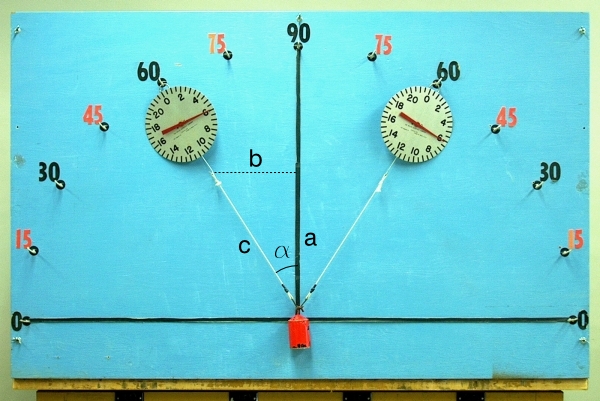
A video of this demonstration is available at this link.
A one-kilogram mass is suspended from two spring scales. You can move the scales to different angles, and show how the tensions in the two ropes change as you do so.
On a level surface, gravity acts downward on a line perpendicular to the surface. (This is the idea behind a plumb bob.) At the earth’s surface, the gravitational force on a 1-kg mass is (1 kg)(9.8 m/s2) = 9.8 kg-m/s2, or 9.8 N. If you could hang both scales at the 90° mark, then, and hang the 1-kg mass from them, each scale would bear half the load, and both scales would read 4.9 N. If you move the scales so that each is exerting a force along a line that makes an angle α with respect to a vertical line, the force on each scale now has two components whose magnitudes are “a” and “b” in the photograph. In terms of the tension in either scale, these are, respectively, T cos α and T sin α. (Note that α is the complementary angle to what is marked on the protractor board, that is, 90 minus the angle marked. For example, in the photograph above, α for both scales is 30 degrees.) In order for the mass to remain in equilibrium, the sum of the two vertical components “a” must equal mg, and the two horizontal components “b” must equal each other. If one scale is set at the angle α1 and the other is set at the angle α2, then this means that
T1 cos α1 + T2 cos α2 = mg and T1 sin α1 = T2 sin α2.
The latter gives T1 = T2 (sin α2)/(sin α1) and T2 = T1 (sin α1)/(sin α2). Substituting these in turn into the first equation (for the vertical components) gives
T1 = (mg sin α2)/(sin α2 cos α1 + sin α1 cos α2)
and
T2 = (mg sin α1)/(sin α2 cos α1 + sin α1 cos α2).
You can place the two scales at any pair of angles you wish, though for some combinations involving the lower angles (75° and 90°, marked 15° and 0° on the board) the rope will not hang exactly at the marked angle.